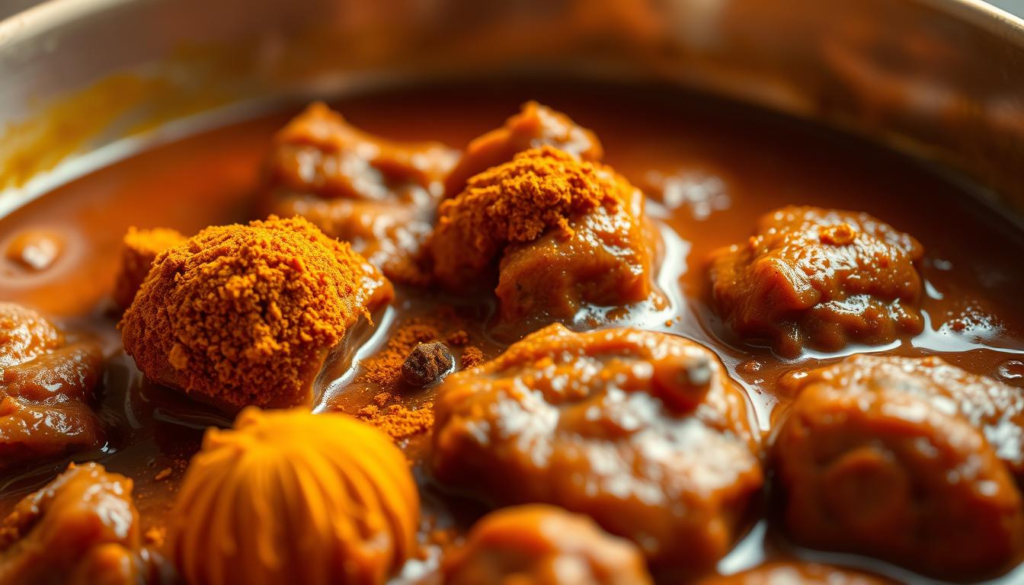Traditional Lamb Curry Recipe: Authentic Indian Comfort
Table of Contents
Introduction
Spices and Stories
The smell of lamb curry is more than food-it’s a trip through family history. Every time I smell the spices, I remember my grandmother’s kitchen. There, slow-cooked lamb made simple ingredients into a feast.
Your lamb curry recipe invites you to dive into Indian cooking. With 1 lb of lamb, you’ll make a dish for four, ready in about 1 hour and 40 minutes.
This curry is more than a recipe. It’s a celebration of taste, skill, and tradition. Each bite shares a story of spices, meat, and family cooking wisdom from India.
Key Takeaways
- Authentic lamb curry requires precision and patience
- Serves 4 people with approximately 445 calories per serving
- Total preparation and cooking time is around 1 hour and 40 minutes
- Uses 1 lb of lamb for a perfect balance of flavor and texture
- Offers a delicious glimpse into traditional Indian cuisine
Essential Ingredients for Traditional Lamb Curry
Making a real homemade lamb curry needs the right ingredients. These add depth and richness to your dish. Knowing what to use will make your Indian lamb curry stand out.
Choosing the Perfect Lamb Cuts
For the best flavor and tenderness, pick these lamb cuts:
- Shoulder cut (most recommended)
- Leg meat
- Boneless lamb chunks
When you use 1 kg (2.2 lbs) of lamb, make sure to drain all excess liquid. Remove yellow fat to get a clean, rich taste in your curry.
Essential Spices and Aromatics
The heart of an Indian lamb curry is its spice mix. Key spices are:
- Garam masala: 2-3 teaspoons
- Turmeric: ½ teaspoon
- Cumin powder: ¾ to 1 teaspoon
- Kashmiri red chili powder: 2-3 teaspoons
- Coriander powder: 1 tablespoon
Additional Crucial Ingredients
To make your Indian lamb curry even better, add these key ingredients:
- 2 cups finely chopped onions
- 1½ cups tomatoes
- 2 tablespoons ginger-garlic paste
- 4 tablespoons fresh mint leaves
- 6 tablespoons oil or ghee
It’s important to balance these ingredients. This will help you make a memorable homemade lamb curry that truly captures the essence of Indian cuisine.
Preparation and Marination Process
Starting a delicious spicy lamb curry begins with preparation and marination. This step turns simple meat into a flavorful dish that will wow your guests.
Spice Blend Preparation
Creating an authentic easy lamb curry starts with the spice blend. Choose your spices to get a balanced flavor:
- Whole spices: cloves, cardamom pods, bay leaves
- Ground spices: cumin, coriander, fennel seeds
- Additional seasonings: turmeric, chili powder
Marination Techniques
Marinating makes the lamb tender and flavorful. Follow these steps:
- Combine yogurt with half of your spice powder
- Add 1 tablespoon of ginger-garlic paste
- Coat lamb chunks with the mixture
Time Management Tips
For better flavor, marinate wisely:
| Marination Duration | Flavor Intensity |
| 30 minutes | Light flavor penetration |
| 2-4 hours | Medium flavor development |
| Overnight (recommended) | Maximum flavor infusion |
Pro tip: For the best flavor, marinate overnight in the fridge. This lets spices deeply penetrate and tenderize the lamb.
Mastering the Cooking Process
Making a tasty lamb curry recipe needs patience and careful cooking skills. It’s a journey from raw ingredients to a delicious slow cooker lamb curry. This journey has several important steps that turn simple parts into a culinary work of art. https://adam-corner.com/food-for-a-healthy-life/

Your lamb curry’s success depends on mastering three key cooking stages:
Perfectly Searing the Lamb
Searing adds incredible flavors and sets the base for your curry. Here are some key tips:
- Use high heat to brown lamb pieces quickly
- Ensure meat is pat-dry before searing
- Work in small batches to prevent overcrowding
- Aim for a golden-brown crust on each piece
Building a Robust Curry Base
The base of your curry is what gives it depth and complexity. Caramelize onions slowly to get a sweet, rich flavor. Add aromatic spices slowly, letting each one release its unique taste.
Slow Cooking Techniques
Slow cooking makes tough lamb cuts tender and delicious. Whether you use a stovetop or a slow cooker, keep the heat low and steady.
- Simmer curry on medium-low heat
- Stir frequently to prevent burning
- Cook for 1-1.5 hours until meat is fork-tender
- Add water if sauce becomes too thick
Pro tip: Bone-in lamb cuts give richer flavors during slow cooking, making your curry even tastier.
The Art of Spice Layering

Spice Layering in Flavorful Lamb Curry
Mastering spice layering is key to making a lamb curry that’s full of flavor. This technique turns a simple dish into a memorable meal. It does this by adding spices at the right times during cooking.
Whole Spices: The Foundation of Flavor
Begin your lamb curry by adding whole spices to hot oil or ghee. These spices release oils that make a flavorful base for your dish. Common whole spices include:
- Cinnamon sticks
- Cardamom pods
- Cloves
- Bay leaves
- Mustard seeds
Ground Spice Integration
Once the whole spices have flavored the oil, mix in ground spices. This coats the lamb and adds depth. For a true lamb curry, use a mix that has:
- Turmeric for color and earthiness
- Coriander powder for a hint of sweetness
- Cumin for warmth
- Red chili powder for spice
Final Seasoning Balance
The key to a great lamb curry is the final seasoning. Add garam masala just before finishing. This step enhances the dish, blending all flavors together.
Spice layering is an art that transforms simple ingredients into a memorable culinary journey.
Achieving the Perfect Consistency
Making a homemade lamb curry with the right sauce consistency is an art. The perfect thickness can turn a good dish into an amazing one. It makes your traditional lamb curry recipe feel like it’s from a restaurant.

Working on your curry, you might face issues with sauce thickness. But, chefs have some top tips to get your sauce just right.
Reducing the Sauce Like a Pro
If your lamb curry sauce is too thin, here’s what to do:
- Take out the cooked lamb pieces first
- Let the sauce simmer uncovered to reduce it
- Stir it often to avoid burning
- Put the lamb back in when it’s the right thickness
Thickening Techniques for Authentic Flavor
There are many ways to thicken your lamb curry:
- Greek yogurt: It makes the sauce creamy and thick
- Tomato puree: It adds texture and flavor
- Coconut milk: It makes the sauce smooth and rich
- Ground nuts: They help thicken it a bit
Liquid Level Adjustment Strategies
| Technique | Impact | Recommended Use |
| Simmering | Reduces liquid volume | Concentrates flavors |
| Adding yogurt | Increases thickness | Balances spice levels |
| Small liquid increments | Controls overall consistency | Prevents watery curry |
Remember, the more you make, the better you’ll get. Each time you make homemade lamb curry, you’ll get better at getting the sauce just right.
Pairing Side Dishes and Accompaniments
Creating the perfect Indian lamb curry experience is more than just the main dish. The right accompaniments can make your meal unforgettable. Let’s look at the best side dishes to go with your lamb curry and make your meal special.
Traditional Rice Options
Rice is key in an Indian lamb curry meal. You can choose from:
- Fragrant Basmati rice (loved by 80% of North Indians)
- Turmeric-infused rice for extra color and taste
- Saffron-garnished Basmati for a fancy touch
Bread Selections
The perfect bread is essential for a great Indian lamb curry. Here are some authentic choices:
- Soft, buttery Naan
- Traditional Roti (used in 95% of Indian homes)
- Crispy Paratha
- Tandoori Roti for a smoky flavor
Complementary Vegetable Dishes

| Side Dish | Preparation Time | Flavor Profile |
| Aloo Gobi | 20 minutes | Spicy potato and cauliflower stir-fry |
| Cucumber Raita | 10 minutes | Cool, refreshing yogurt-based side |
| Bombay Potatoes | 20 minutes | Spicy and tangy potato dish |
“The right side dishes can turn a simple meal into a memorable feast.” – Indian Culinary Expert
Pro tip for your delicious lamb curry recipe: Make side dishes ahead of time to avoid last-minute stress. Most vegetable sides and breads can be made ahead and reheated quickly before serving.
Storage and Reheating Guidelines
Making a tasty spicy lamb curry is a big job. So, it’s smart to keep it fresh for a few days. The right storage keeps your curry’s rich flavors and soft meat.
Proper Storage Methods
After dinner, put your curry in a sealed container. This keeps it fresh for up to 5 days. It’s great for meal prep and leftovers.
- Use glass or plastic containers with tight-fitting lids
- Cool the curry to room temperature before storing
- Divide into portion-sized containers for easy reheating
Freezing Your Curry
Your curry freezes really well. This means you can enjoy it for weeks. It stays good for 3-4 months in the freezer.
| Storage Location | Maximum Storage Time |
| Refrigerator | Up to 5 days |
| Freezer | 3-4 months |
Reheating Techniques
To keep your curry tasting great, follow these reheating tips:
- Thaw frozen curry overnight in the refrigerator
- Reheat in a covered pan over medium-low heat
- Stir occasionally to prevent sticking
- Add a small amount of water or stock if needed to restore moisture
Pro tip: Curries often taste better the next day as the flavors continue to develop and meld together!
By using these storage and reheating tips, your curry stays delicious and safe. You can enjoy it many times.
Variations and Adaptations
Your authentic lamb curry recipe is incredibly versatile. It allows for exciting regional and dietary modifications. Whether you’re looking to explore different flavor profiles or accommodate specific dietary needs, this flavorful lamb curry can be easily adapted to suit your preferences.
Regional variations of Indian lamb curry showcase the incredible diversity of culinary traditions across different states. Each region brings its unique touch to this classic dish, creating a rich tapestry of flavors and cooking styles.
Regional Flavor Explorations
- Kashmiri Style: Incorporates dried Kashmiri chilies for a vibrant red color and mild heat
- Punjabi Variation: Adds rich cream and butter for a more indulgent texture
- South Indian Twist: Includes coconut milk and curry leaves for a distinctive taste
Dietary Adaptations
Your flavorful lamb curry can be easily modified to meet various dietary requirements:
- Dairy-free version: Replace yogurt with coconut milk
- Low-fat option: Use lean lamb cuts and reduce oil
- Gluten-free preparation: Ensure all spices are certified gluten-free
Spice Level Customization
Adjusting the spice level allows everyone to enjoy this authentic lamb curry. Start with minimal cayenne and gradually increase to find your perfect heat balance. For a milder version, reduce or eliminate hot spices, while heat lovers can add extra cayenne or green chilies.
Pro tip: You can enhance your lamb curry by adding vegetables like potato chunks, cauliflower florets, or taro root during the last 15 minutes of cooking. A handful of peas added at the end can also provide a delightful burst of color and nutrition.
Troubleshooting Common Issues
Preparing a traditional lamb curry recipe can sometimes present challenges, even for experienced home cooks. Don’t worry – this guide will help you navigate some common cooking hurdles and ensure your homemade lamb curry turns out perfectly every time.
Dealing with Tough Meat
Tough lamb can ruin an otherwise delicious curry. To guarantee tender meat in your traditional lamb curry recipe, consider these tips:
- Choose the right cut of lamb with some marbling
- Marinate the meat for at least 30 minutes
- Cook on low heat for extended periods
- Use a slow cooker for maximum tenderness
Fixing an Overly Spicy Curry
Accidentally made your homemade lamb curry too hot? No problem! Try these quick fixes:
- Add a dollop of yogurt or cream
- Stir in some coconut milk
- Include diced potatoes to absorb excess heat
- Squeeze fresh lime juice to balance spiciness
Adjusting Salt Levels
Salt can make or break your traditional lamb curry recipe. When your curry seems too salty, try these solutions:
- Add chunks of potato to absorb excess salt
- Mix in more unsalted tomato puree
- Dilute with additional coconut milk or water
- Balance with a pinch of sugar
With these troubleshooting techniques, you’ll confidently master your homemade lamb curry, transforming potential cooking mishaps into delicious culinary successes.
Serving and Presentation Tips
Creating a memorable dining experience is more than just cooking a tasty lamb curry. How you serve and present your Indian lamb curry can make a big difference. It can turn a simple meal into a special culinary adventure.
Plating Techniques That Impress
Here are some tips to make your Indian lamb curry look amazing:
- Use wide, shallow ceramic bowls to show off the curry’s rich color
- Create a small dent in the basmati rice for the curry to gather in
- Make sure the lamb pieces are visible and arranged nicely
- Keep the plate edges clean for a polished look
Garnishing with Flair
A little garnish can take your lamb curry from great to incredible. Fresh herbs are key for adding color and flavor.
- Sprinkle 1 tablespoon of chopped coriander leaves over the curry
- Add a few whole cilantro leaves for a fancy touch
- Garnish with thin slices of fresh green chili for a spicy kick
- Consider a dollop of cooling yogurt to balance the spices
Creating a Festive Atmosphere
Your Indian lamb curry deserves a special setting. Dim the lights, play soft Indian classical music, and use traditional serving plates. This will take your guests on a journey to the heart of India.
Pro tip: Let your curry rest for 10-15 minutes before serving. This lets the flavors blend and get even more delicious, making your meal unforgettable.
Conclusion: Mastering the Art of Traditional Lamb Curry
Your journey to make an authentic lamb curry is more than cooking. It’s about centuries of culinary tradition. You’ve mixed Portuguese and Indian spices to create something special.
By following each step, you’ve learned how slow cooking and spice selection can transform a simple dish. This makes the lamb curry rich and complex.
The lamb curry you’ve made shows the value of patience and skill. You’ve picked the right lamb and balanced the spices perfectly. Your kitchen can now make generations of Indian dishes.
Remember, cooking is about trying new things and making it your own. Even though you followed traditional methods, feel free to change things up. Each time you make this curry, you’ll get better and make it your own.
Enjoy the process, share with your loved ones, and keep exploring Indian cuisine. It’s a world full of flavors and traditions waiting to be discovered.
FAQ
What cut of lamb is best for a traditional curry?
For a tender and flavorful curry, choose shoulder, leg, or boneless chunks. These cuts have the right mix of meat and fat. This makes the curry rich and falls apart easily when slow-cooked.
How long should I marinate the lamb for the best flavor?
Marinate the lamb for 2-4 hours for great flavor. But, marinating overnight (8-12 hours) will give you the most intense taste. The yogurt and spice mix tenderizes the meat and lets spices penetrate deeply.
Can I make this lamb curry in a slow cooker?
Yes! A slow cooker is perfect for lamb curry. Cook on low for 6-8 hours or high for 4-5 hours. This makes the meat tender and lets flavors fully develop.
How can I make the curry less spicy?
To make it less spicy, use fewer red chili peppers or less dried chili powder. Adding yogurt, coconut milk, or a bit of cream can also help. Serving with cooling sides like raita can also balance the heat.
How do I store leftover lamb curry?
Store leftover curry in an airtight container in the fridge for 3-4 days. Freeze for up to 3 months for longer storage. Always cool it completely before refrigerating or freezing, and reheat well before serving.
What are the must-have spices for an authentic lamb curry?
Essential spices include garam masala, turmeric, cumin, coriander, cardamom, and cinnamon. Don’t forget fresh ginger and garlic for deep, complex flavors.
Can I make this curry dairy-free?
Yes! Use coconut milk or dairy-free yogurt instead of yogurt. Replace ghee with oil and make sure all ingredients are dairy-free. The key is to keep the spice and flavor balance right.
What’s the best way to thicken the curry sauce?
To thicken the sauce, reduce it over low heat or add ground nuts like almonds. You can also use yogurt or cream, or a bit of tomato paste. Cooking uncovered helps concentrate flavors and thicken the sauce.








